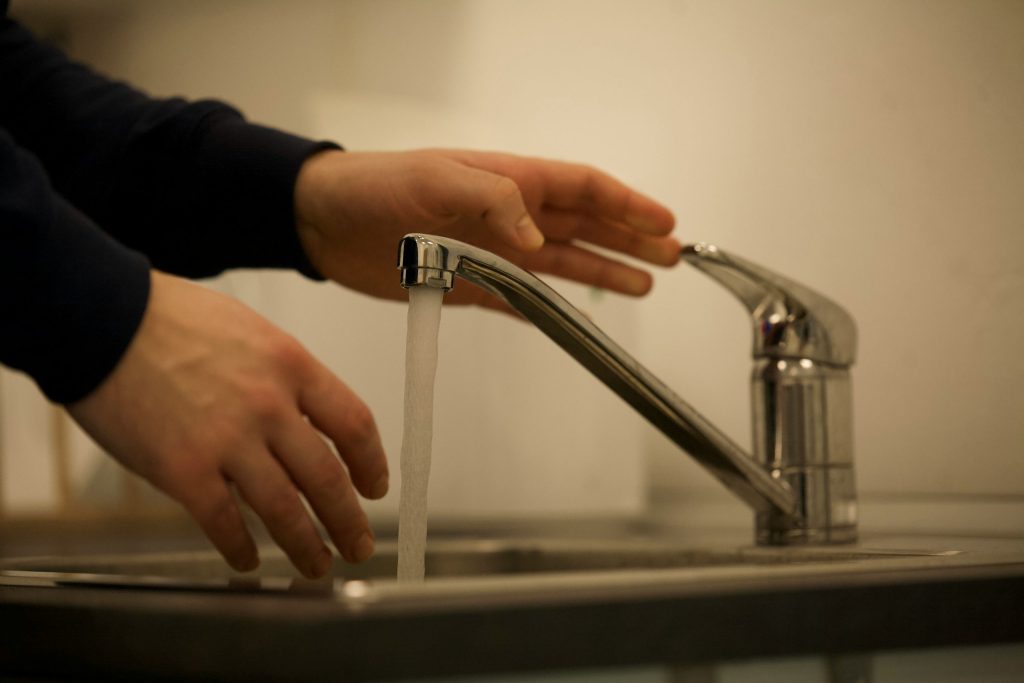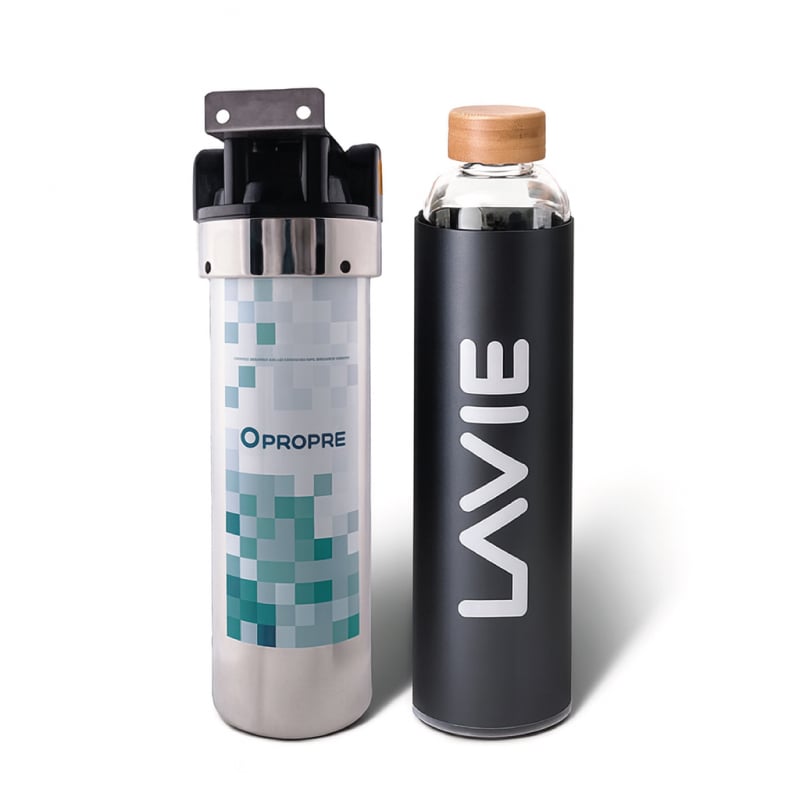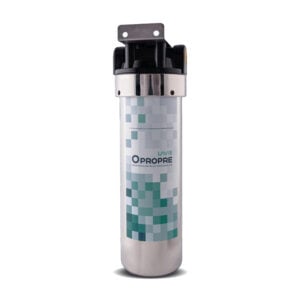
30-day money-back guarantee *
30-day money-back guarantee *

PFASs, better known as "eternal pollutants", are a group of thousands of substances that are present in the environment. chemical substances used for decades in our everyday products. Unfortunately, they circulate in the environment, in our pipes and find their way into our glasses.
Their extreme resistance worries the health authorities, because these harmful compounds accumulate in the body and are suspected of promoting certain cancers, disrupting hormonal balance and weakening the immune system. The problem is that very few devices manage to eliminate them effectively. So how do you filter PFAS from tap water? In this article, we take a look at the products on the market and their effectiveness. PFAS water filter the most reliable way to protect your home.
PFASs, or per- and polyfluoroalkylated substances, are a type of man-made toxic compounds since the 1950s. Used for their non-stick, waterproof and heat-resistant properties, they are found in many everyday products. However, these contaminants do not break down and accumulate everywhere in the environment (in the soil and groundwater), even in drinking water in the home.
In France, several surveys have revealed worrying levels in water. On 30 July 2025, the French Ministry of Ecology published a map showing the presence of PFAS in water: 39 sampling points exceed regulatory thresholds.
Their major impact on health is very worrying: hormonal disruption, weakening of the immune system, increased risk of cancer (PFOA and PFOS are now classified as "carcinogenic to humans") and effects on child development. And unfortunately, eliminating PFAS is no easy task: conventional water treatment plants are unable to do so, and most domestic technologies retain them only very partially, if at all. So which PFAS water filters can really make a difference?
Faced with the dangers of PFAS, more and more households are wondering which treatment to choose to protect their health. But the question is: are they really effective against these chemicals? To help you make sense of it all, here's a comparison table that reviews the main PFAS treatments. filtration solutions and their actual results against PFAS and other contaminants.
|
Element filtered, reduced or eliminated |
Classic carafe filter |
Tap filter |

Osmosis unit |

Opropre under-sink filter |

Peace of mind pack (Opropre + LAVIE PURE) |
| Chlorine | ✅ | ✅ | ✅ | ✅ | ✅ |
| Sediment | ✅ | 🟠 | ✅ | ✅ | ✅ |
| Bacteria | ❌ | ❌ | ❌ | ❌ | ✅ |
| Virus | ❌ | ❌ | ❌ | ❌ | ✅ |
| Medicines | ❌ | ❌ | ✅ | ✅ | ✅ |
| Heavy metals | 🟠 | 🟠 | ✅ | ✅ | ✅ |
| Pesticides | ❌ | ❌ | ✅ | ✅ | ✅ |
| PFAS | ❌ | ❌ | ✅ | ✅ | ✅ |
| Microplastics | ❌ | ❌ | ✅ | ✅ | ✅ |
| Mineral conservation beneficial |
❌ | 🟠 | ❌ | ✅ | ✅ |
| Discover | Discover |
Classic filter carafes (Brita, Philips, Amazon...) seduce by their practicality They reduce chlorine, correct taste and retain certain impurities. But the answer is simple: they are no match for PFAS! Designed with activated carbon (sometimes coupled with an ion exchange resin), the filter carafes are not effective against PFAS. And there are other problems too: filters that have to be changed every 3 to 4 weeks, plastic waste that is not recycled, frequent bacterial growth and even the release of microplastics and various toxic products.
In short, using a carafe filter does not protect your health from the presence of PFAS in tap water.
💧 See also: Carafe filter: Is it effective against PFAS?
Tap-side filters are attractive for their simplicity: they are easy to install, take up little space and are effective against chlorine, certain odours, heavy metals and microplastics. But when it comes to the persistence of PFAS in water, the conclusion is clear: they are not designed to retain these eternal pollutants. Their technology is based mainly on activated carbon, which is useful for improving taste, but can also be used to remove pollutants such as chlorine, heavy metals and microplastics. insufficient against such resistant substances.
And there are other limitations: the flow rate is often reduced, the cartridges have to be replaced every 30 days and they cannot be recycled. A back-up solution, but far from a lasting and powerful treatment against PFAS.
Not all under-sink filters are created equal. Many rely solely on activated carbon: effective for eliminating certain impurities, but insufficient for dealing with compounds as tenacious as PFAS. But one system stands out: Opropre Turquoise, developed by LAVIE in France!
His secret? A double performanceIt combines high quality coconut activated carbon and an anti-PFAS ion exchange resin, capable of trapping these persistent substances over the long term. From independent testing conducted by the Aix-Marseille University laboratory confirmed this: up to 27.4 mg of PFOA and 23.8 mg of PFBA were retained per gram of resin, i.e. higher quantities than in French drinking water.
And the list of benefits goes on: Opropre cartridges are returnable and refillable, to avoid the production of unnecessary plastic waste. Used carbon and resin are recycled in specialised circuits. Result: quality waterIt's a balanced, sustainable solution that's good for your health and that of the planet!

Reverse osmosis is one of the few solutions capable of eliminating up to 99 % of PFAS. A formidable performance, used both in industry and in private homes. But this efficiency comes at a price:
In a nutshell, reverse osmosis treatment eliminates PFAS, but its various constraints mean that not a recommended option for domestic use. A system to be avoided.
💧 See also: Osmosis to combat PFAS: effective, but at what price?
Reverse osmosis treatment is based on a highly advanced process The water is forced at high pressure through an ultra-thin membrane made up of several layers. This barrier retains almost all substances, even the necessary ones: nitrates, pesticides, heavy metals, drug residues and, of course, PFAS. Efficiency close to 99 %.
But this performance comes at a price: demineralised water, disastrous wastage and high running costs. A radical method, but dangerous in the long term for your health and that of the environment.
To find out more, discover the advantages and disadvantages of reverse osmosis in this article.
Activated carbon works like a sponge. Its porous surface captures certain molecules present in drinking water, including chlorine, organic residues, pesticides and some PFAS.
But this effectiveness remains limited This process mainly affects long-chain PFASmuch less on short chains, which are more difficult to retain. The result: a useful technology, but insufficient on its own to combat PFAS contamination.
Ion exchange resin is a formidable technology against PFAS. In concrete terms, its microporous beads act by exchanging certain ions present in the water with ions of similar charge. This process traps even the most stubborn PFAS. And unlike activated carbon, which mainly targets long-chain PFAS, the resin also retains short-chain PFAS, which are more difficult to eliminate.
The Opropre Turquoise tap water filter uses precisely this technology: by combining it with high-quality coconut activated carbon, it removes both long- and short-chain PFAS, while preserving essential minerals. The result: healthy, balanced drinking water and a sustainable solution that protects both your health and the planet.

Bottled water often appears to be a reassuring alternative to the contamination of water by PFAS. Yet this option is far from ideal for your health, your budget and the environment.
Studies have revealed the presence of microplastics in the majority of bottles, and some analyses have even detected traces of PFAS.
In practical terms, drinking only bottled water is much more expensive than a domestic filtration system, not to mention the transport and storage constraints.
Finally, the ecological impact is immense: catastrophic pollution from billions of plastic bottles every year on our planet.
So you see: bottled water is not the solution. Far from it.
Filtering drinking water is the first step towards limit exposure to PFAS. But these pollutants don't just lurk in our pipes. Designed to resist water, grease and heat, they are found in many everyday products: non-stick frying pans, waterproof textiles, food packaging, fire-fighting foams and waterproof cosmetics.
To reduce your exposure, a few simple steps can make all the difference:
Combined with a PFAS water filter, these reflexes reduce your exposure and are holding back the spread of PFAS in the environment.
Not all filtration systems are equal when it comes to the PFAS present in water. Carafes and tap filters are inadequate, while reverse osmosis is effective but dangerous to health, not to mention its ecological impact.
But one innovative treatment stands out! Opropre Turquoise under-sink filter is now the healthiest, most reliable solution. Thanks to its combination of coconut activated carbon and anti-PFAS ion exchange resin, it eliminates these eternal pollutants while preserving the minerals essential to your body. And there's no need for chemicals.
Result: for safe, long-lasting hydration, Opropre Turquoise is the ideal choice.
The only protection against PFAS contamination in water is to filtration treatment. But conventional products are not enough. For example, carafes or tap filters are not effective. The Opropre Turquoise under-sink filter, on the other hand, traps PFAS for a long time thanks to its ion exchange resin and activated carbon, while preserving the minerals essential to your health.
Not all water filters are designed to remove PFAS. Conventional solutions, such as carafes and filters on tap, do not retain them. Only certain advanced technologies, such as anti-PFAS ion exchange resinThese chemical substances are eliminated by the skin. This is precisely what is found in Opropre Turquoise to provide reliable, long-lasting filtration.
The Opropre Turquoise under-sink filter, developed by LAVIE, is today the safest and healthiest solution. It combines coconut activated carbon and anti-PFAS ion exchange resin to trap these eternal pollutants effectively. The result: high quality drinking water that's balanced, pleasant to drink and environmentally friendly.
Want to keep up to date with our water-related articles?
Subscribe to our Newsletter below
and get -5% on your first order!